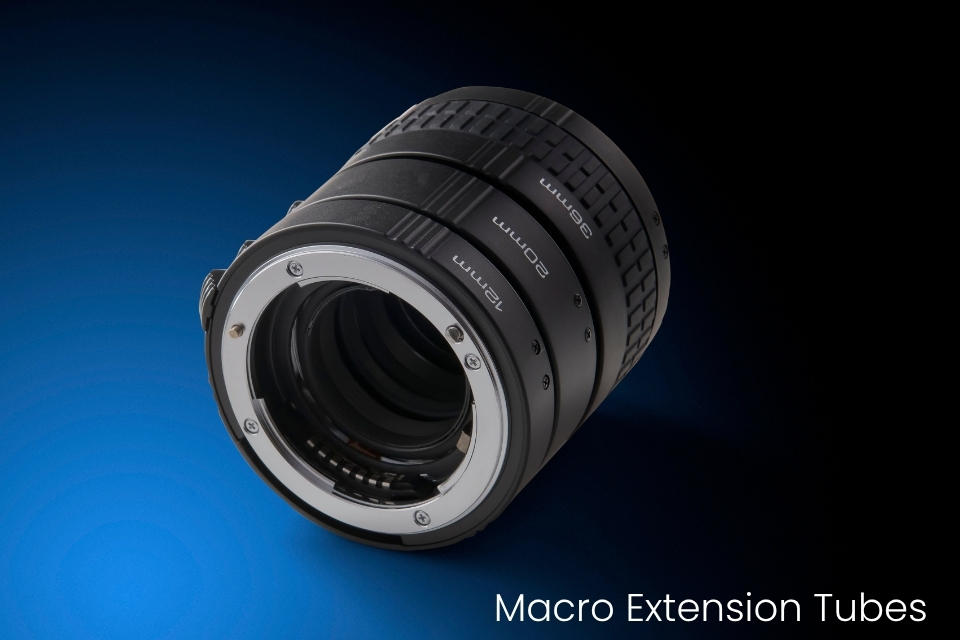Extension Tubes in Action: How to Get Beautiful Close-Ups with Your Regular Lens
Want to take stunning macro photos without buying a new lens?

If you’ve got a trusty 50mm or 85mm prime lying around, extension tubes can transform it into a macro powerhouse — no glass, no fuss, just results.
In this guide, we’ll walk you through:
- What extension tubes do (and how)
- How to set them up for your camera
- Real-world examples and tips to get the best results
- Common mistakes and how to avoid them
🛠️ What Are Extension Tubes, Really?
Extension tubes are hollow rings that sit between your camera body and lens.
Unlike teleconverters or filters, they contain no glass. Their only job is to increase the distance between the lens and sensor, allowing your lens to focus closer — which means more magnification.
📏 Think of it like holding a magnifying glass farther from your eye — it focuses on smaller details.
⚙️ How to Use Them: Step-by-Step
- Choose your lens: Prime lenses between 35mm and 85mm work best. Zoom lenses can work too, but primes tend to deliver sharper images and easier focusing.
- Attach the extension tube to your camera: Mount it like a lens.
- Mount your lens onto the tube: Align and twist as you normally would.
- Set your camera to manual focus: While autofocus may work with electronic tubes, most macro shooters prefer manual focusing for precision.
- Move your camera forward and backward: Instead of using the focus ring, physically move the camera to bring your subject into sharp focus.
🧠 Pro Tip: Use live view or focus peaking if your camera has it — it helps with precise focus in shallow depth-of-field conditions.
🔎 Real-Life Example: How Extension Tubes Bring You Closer
Take a look at these blueberries.

Each photo was taken with the same lens, but different extension tube lengths:
- 12mm shows the whole berry with a bit of context
- 24mm brings the subject closer, filling more of the frame
- 36mm gets so close you can see surface textures and fine details
This simple setup shows how extension tubes let your lens focus closer without changing the lens itself.
The more extension you add, the more magnification you get — perfect for capturing textures, patterns, and tiny details that are invisible in a normal shot.
Whether you’re shooting fruit, flowers, or fabric, extension tubes can turn everyday subjects into stunning close-up art.
Pair it with good natural light or a cheap LED ring light, and your results will look like they came from a far more expensive setup.
Wondering how much closer your extension tubes will get you? Take a look at this simple guide on how magnification works, or use the extension tube calculator for precise values.
💡 Tips for Better Results
- Use a tripod: Even the tiniest shake is magnified at macro distances.
- Shoot with a smaller aperture (f/8 to f/11): This increases depth of field slightly and helps with overall sharpness.
- Add light: Use soft diffused lighting (natural or artificial). Even a desk lamp with a tissue diffuser can do wonders.
- Stack your tubes: Want more magnification? Most tubes come in sets (e.g., 12mm, 20mm, 36mm) that can be combined — just know this will cost you more light.
🔦 Did You Know?
For every 25mm of extension, you can gain roughly 0.5x magnification on a 50mm lens.
⚠️ Common Pitfalls to Avoid
- Don’t expect infinity focus: With tubes attached, your lens won’t focus on distant objects.
- Watch your exposure: Tubes reduce the amount of light hitting the sensor. Use a slower shutter speed or higher ISO if needed.
- Cheap tubes may lack electronic contacts: This means no autofocus or aperture control on modern lenses.
Try to get a set with pass-through contacts (especially for Canon EF, Nikon F, Sony E-mount, etc.).
📸 Extension Tube Buying Guide
| Brand | For Mount | With Contacts? | Typical Price (USD) | Best For |
|---|---|---|---|---|
| Kenko Extension Set | Canon/Nikon/Sony | ✅ Yes | $120–150 | Best optical quality |
| Neewer Tube Set | Multiple | ✅ Yes | $40–60 | Budget pick |
| Meike Tube Set | Canon/Nikon/Sony | ✅ Yes | $50–80 | Good value |
| Generic Tubes | Any | ❌ No | $15–30 | Manual lenses only |
🧵 Summary: Tiny Tube, Big Impact
Extension tubes are one of the easiest, cheapest, and most effective ways to get into macro photography.
They teach you to slow down, think creatively, and truly see the world up close.
So next time you’re tempted by a $1000 macro lens… pause.
Grab a $50 tube set instead and go explore a flower, a watch face, or the stitching on your jacket.
You might be surprised what you find.
👉 Coming Next: Reverse Lens Macro: Ultra-Close Photography on a Micro Budget